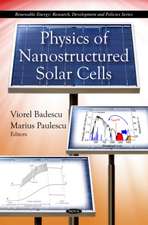Modeling Solar Radiation at the Earth's Surface: Recent Advances
Editat de Viorel Badescuen Limba Engleză Hardback – 22 feb 2008
Solar radiation data must be provided in a variety of forms to suit these applications. The radiation reaching the upper atmosphere of the Earth is a quantity rather constant in time. But the radiation reaching some point on Earth surface is random in nature. The main cause is the fact that various gases within the atmosphere absorb solar radiation at different wavelengths, and clouds and dust also affect it.
There are two ways to obtaining solar radiation data at ground level: by measurement and by modelling. The book will facilitate the calculation of solar radiation required by engineers, designers and scientists and, as a result, will increase the access to needed solar radiation data.
| Toate formatele și edițiile | Preț | Express |
|---|---|---|
| Paperback (1) | 652.81 lei 6-8 săpt. | |
| Springer Berlin, Heidelberg – 29 noi 2014 | 652.81 lei 6-8 săpt. | |
| Hardback (1) | 657.73 lei 6-8 săpt. | |
| Springer Berlin, Heidelberg – 22 feb 2008 | 657.73 lei 6-8 săpt. |
Preț: 657.73 lei
Preț vechi: 773.80 lei
-15% Nou
Puncte Express: 987
Preț estimativ în valută:
125.87€ • 130.93$ • 103.91£
125.87€ • 130.93$ • 103.91£
Carte tipărită la comandă
Livrare economică 14-28 aprilie
Preluare comenzi: 021 569.72.76
Specificații
ISBN-13: 9783540774549
ISBN-10: 3540774548
Pagini: 552
Ilustrații: XXXIII, 517 p. With online files/update.
Dimensiuni: 155 x 235 x 39 mm
Greutate: 0.9 kg
Ediția:2008
Editura: Springer Berlin, Heidelberg
Colecția Springer
Locul publicării:Berlin, Heidelberg, Germany
ISBN-10: 3540774548
Pagini: 552
Ilustrații: XXXIII, 517 p. With online files/update.
Dimensiuni: 155 x 235 x 39 mm
Greutate: 0.9 kg
Ediția:2008
Editura: Springer Berlin, Heidelberg
Colecția Springer
Locul publicării:Berlin, Heidelberg, Germany
Public țintă
ResearchCuprins
Solar Radiation Measurement: Progress in Radiometry for Improved Modeling.- Fractal Classification of Typical Meteorological Days from Global Solar Irradiance: Application to Five Sites of Different Climates.- Modelling the Statistical Properties of Solar Radiation and Proposal of a Technique Based on Boltzmann Statistics.- A Method for Determining the Solar Global and Defining the Diffuse and Beam Irradiation on a Clear Day.- Recent Advances in the Relations between Bright Sunshine Hours and Solar Irradiation.- Solar Irradiation Estimation Methods from Sunshine and Cloud Cover Data.- Solar Irradiation via Air Temperature Data.- Models of Diffuse Solar Fraction.- Estimation of Surface Solar Radiation with Artificial Neural Networks.- Dynamic Behavior of Solar Radiation.- Time Series Modelling of Solar Radiation.- A new Procedure to Generate Solar Radiation Time Series from achine Learning Theory.- Use of Sunshine Number for Solar Irradiance Time Series Generation.- The Meteorological Radiation Model (MRM): Advancements and Applications.- Chain of Algorithms to Compute Hourly Radiation Data on Inclined Planes used in Meteonorm.- Modelling UV–B Irradiance in Canada.- Angular Distribution of Sky Diffuse Radiance and Luminance.- Solar Radiation Derived from Satellite Images.- Generation of Solar Radiation Maps from Long-Term Satellite Data.- Validation and Ranking Methodologies for Solar Radiation Models.
Textul de pe ultima copertă
Solar radiation data is important for a wide range of applications, e.g. in engineering, agriculture, health sector, and in many fields of the natural sciences. A few examples showing the diversity of applications may include: architecture and building design e.g. air conditioning and cooling systems; solar heating system design and use; solar power generation; weather and climate prediction models; evaporation and irrigation; calculation of water requirements for crops; monitoring plant growth and disease control; skin cancer research.
Solar radiation data must be provided in a variety of forms to suit these applications. The radiation reaching the upper atmosphere of the Earth is a quantity rather constant in time. But the radiation reaching some point on Earth surface is random in nature. The main cause is the fact that various gases within the atmosphere absorb solar radiation at different wavelengths, and clouds and dust also affect it.
There are two ways to obtaining solar radiation data at ground level: by measurement and by modelling. The book will facilitate the calculation of solar radiation required by engineers, designers and scientists and, as a result, will increase the access to needed solar radiation data.
Solar radiation data must be provided in a variety of forms to suit these applications. The radiation reaching the upper atmosphere of the Earth is a quantity rather constant in time. But the radiation reaching some point on Earth surface is random in nature. The main cause is the fact that various gases within the atmosphere absorb solar radiation at different wavelengths, and clouds and dust also affect it.
There are two ways to obtaining solar radiation data at ground level: by measurement and by modelling. The book will facilitate the calculation of solar radiation required by engineers, designers and scientists and, as a result, will increase the access to needed solar radiation data.
Caracteristici
Covers all the aspects of solar radiation computing models Provides a solid understanding of the main mechanisms which determine the behaviour of solar radiation on earth surface and how solar radiation is estimated, measured and interpreted in an applied world. All authors are experienced well-known researchers, enjoying worldwide fame as physicists and engineers involved in solar radiation estimation Includes supplementary material: sn.pub/extras





















